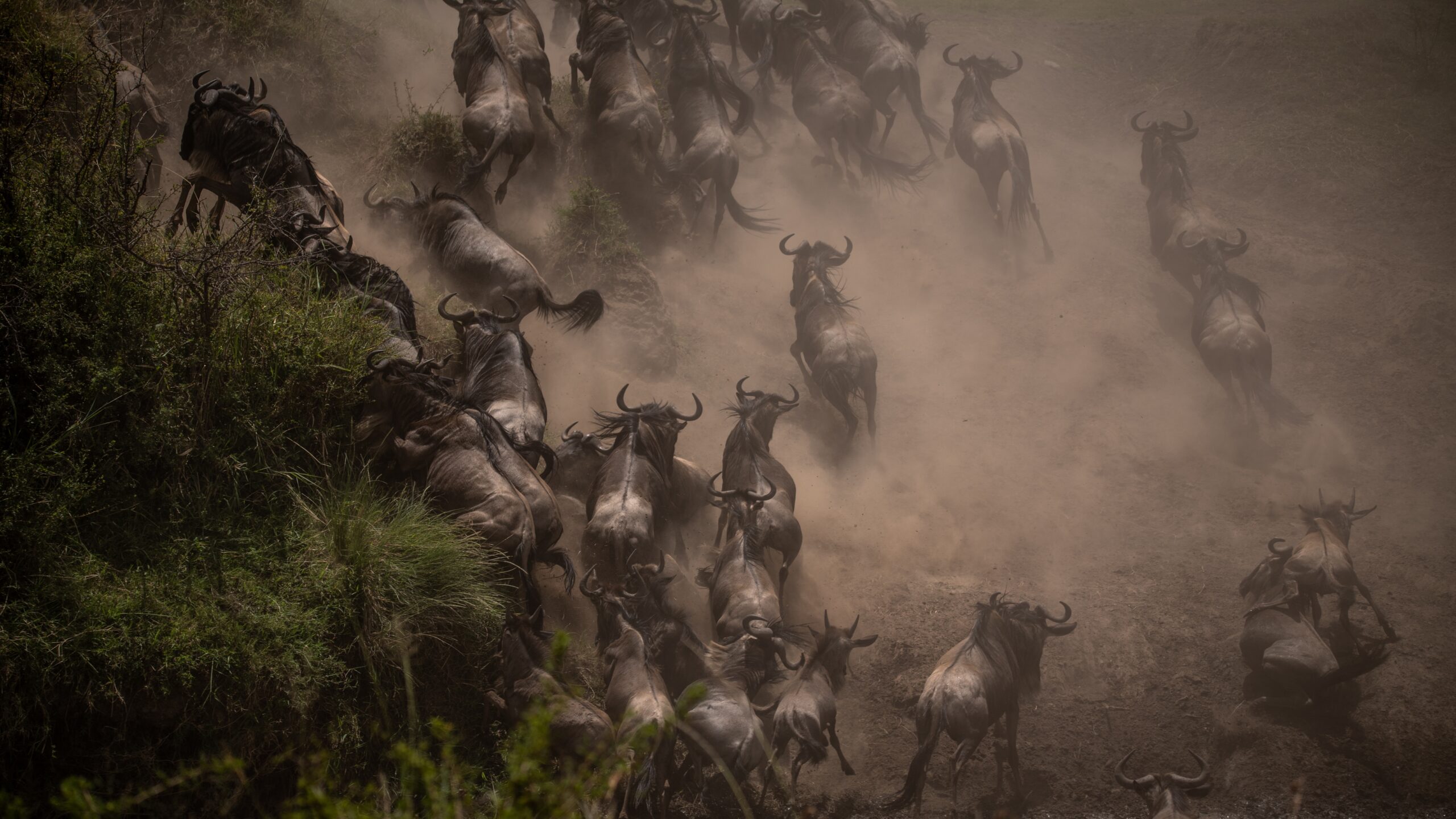
+351 916 222 010
info@kenyasoulsafaris.com
Every year, the vast plains of the Maasai Mara in Kenya bear witness to one of the most awe-inspiring natural events on the planet – The Great Wildebeest Migration. This mass movement of over two million wildebeests, zebras, and gazelles traversing the Serengeti-Mara ecosystem is a truly magnificent sight that attracts travelers from all corners of the globe.
Join us on this journey as we explore the incredible phenomenon of the Great Migration, the best times to witness it, and how to experience it with a remarkable Kenya Soul Safaris adventure.
The Great Migration is driven by the never-ending search for greener pastures and life-sustaining water. Every year, this relentless cycle unfolds as follows:
January to March: The animals congregate in Tanzania’s Serengeti National Park, where they give birth to over 500,000 calves within a three-week window.
April to June: As the rains cease in the Serengeti, the herds start moving northwest, following the scent of fresh grass.
July to September: The most dramatic stage of the migration takes place when the animals arrive at the Maasai Mara, crossing the perilous Mara River infested with crocodiles. This is the best time to witness the Great Migration in Kenya.
October to December: The herds return south to Tanzania’s Serengeti plains, completing their circular migration.
The Great Migration is not just about wildebeests. Travelers can also catch sight of:
To fully immerse yourself in this once-in-a-lifetime event, consider booking one of the following Kenya Soul Safaris packages:
This all-inclusive safari takes you on a journey through the Maasai Mara, where you’ll enjoy game drives, luxurious accommodations, and exquisite dining experiences. Highlights include:
If you’re seeking a more budget-friendly option, this safari offers an authentic experience without compromising on comfort. Highlights include:
For an unforgettable bird’s-eye view of the Great Migration, consider adding a hot air balloon safari to your itinerary. As you float over the Maasai Mara at sunrise, you’ll witness the herds moving below and marvel at the sheer scale of this natural wonder.
To make the most of your Great Migration experience, keep the following tips in mind:
The Great Wildebeest Migration in the Maasai Mara is not only a display of the perseverance of herbivores, but it also serves as a thrilling showcase of Africa’s top predators in action.
Lions, leopards, and cheetahs, along with other carnivores, take advantage of this annual event to hunt and feed on the migrating herds.
This dynamic interaction between predator and prey is a crucial aspect of the ecosystem’s balance and offers a rare opportunity for visitors to witness the circle of life in real-time.
The Maasai Mara is home to the Maasai people, a semi-nomadic tribe known for their rich culture and close relationship with the environment.
The Great Wildebeest Migration plays a significant role in supporting the livelihoods of these communities through tourism revenue.
Thousands of visitors flock to the region each year to witness this natural spectacle, contributing to the local economy and helping to promote sustainable conservation practices.
By traveling responsibly and engaging with local communities, visitors can ensure that the Maasai Mara remains a thriving and protected destination for generations to come.
The Great Wildebeest Migration in the Maasai Mara is a unique and fragile phenomenon that requires ongoing conservation efforts to ensure its survival.
Climate change, human encroachment, and poaching pose significant threats to the Serengeti-Mara ecosystem and the migration itself.
Collaborative efforts between governments, NGOs, and local communities are underway to implement sustainable land management practices, combat poaching, and protect critical wildlife habitats.
As a visitor, you can contribute to these conservation efforts by supporting responsible tourism operators, engaging in eco-friendly practices, and spreading awareness about the importance of preserving this incredible natural event.
Q: What is the best time to see the Great Migration?
A: The best time to see the Great Migration in Kenya is from July to September when the herds cross the Mara River in the Maasai Mara.
Q: Has the Great Migration started in the Masai Mara?
A: The Great Migration typically reaches the Masai Mara in July, but the exact timing varies each year, depending on factors such as rainfall and grass availability.
Q: What is the Great Wildebeest Migration?
A: The Great Wildebeest Migration is an annual movement of over two million wildebeests, zebras, and gazelles between Tanzania’s Serengeti National Park and Kenya’s Maasai Mara National Reserve in search of food and water.
Q: What month is the Great Migration in Kenya?
A: The Great Migration is usually in Kenya’s Maasai Mara between July and September, with the peak viewing period occurring in August and September.
Embarking on a journey to witness the Great Wildebeest Migration in the Maasai Mara is an experience unlike any other. By booking a Kenya Soul Safaris package, you’ll be one step closer to witnessing this breathtaking natural spectacle firsthand. So pack your bags, grab your camera, and prepare for the adventure of a lifetime!